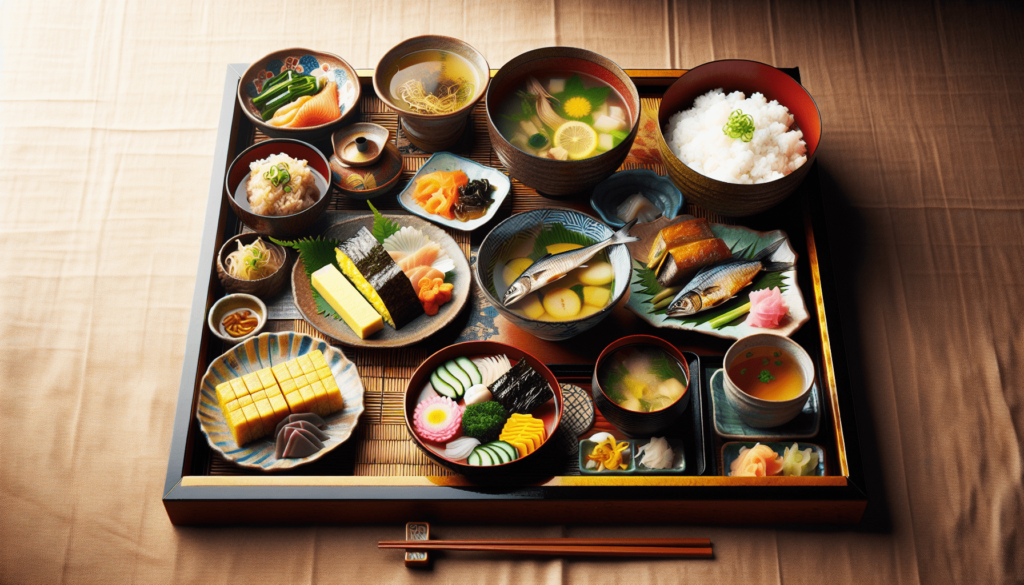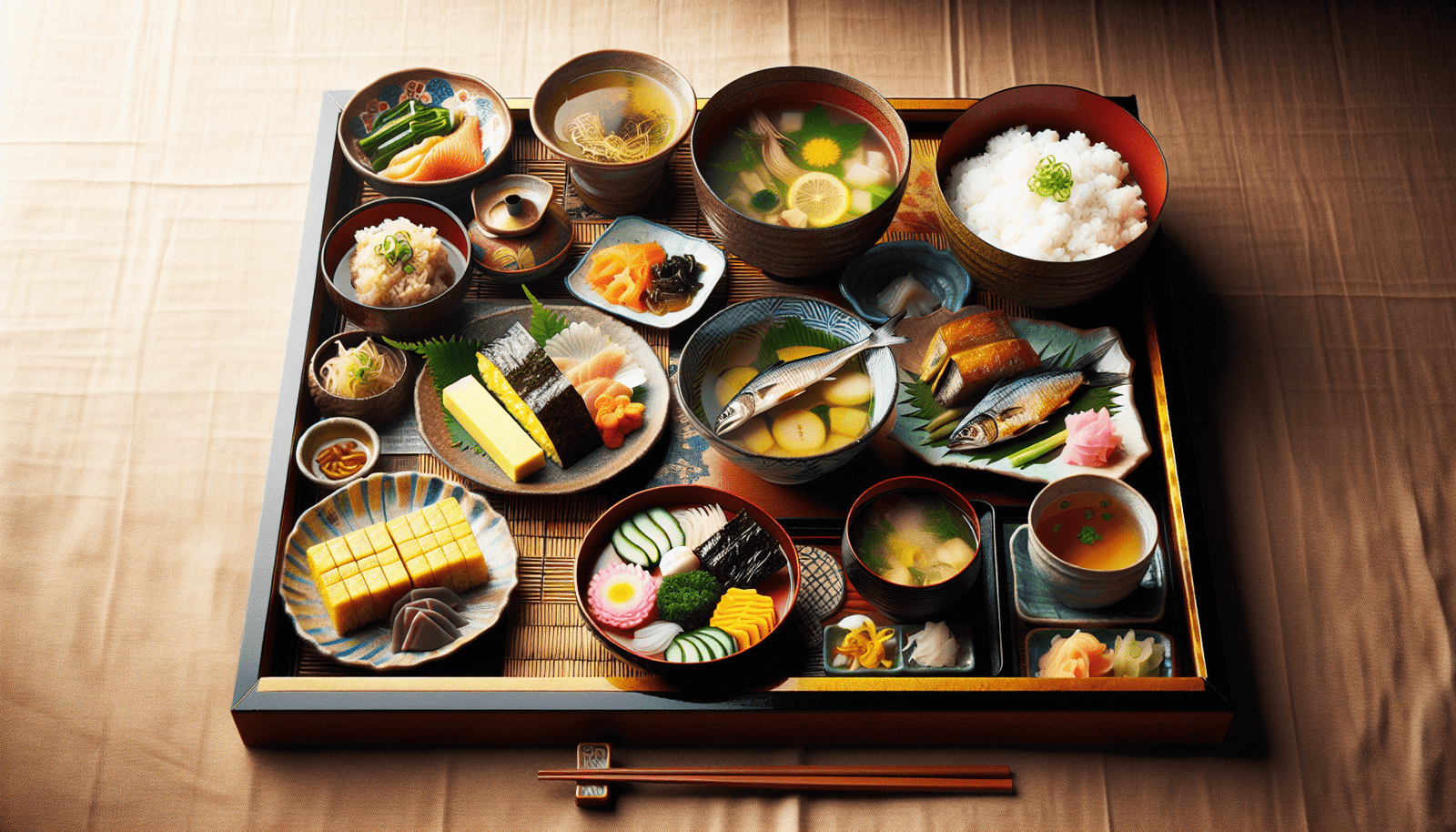Are you tired of the same old breakfast routine? Looking to add some variety and deliciousness to your mornings? Look no further than the mouthwatering Japanese Breakfast Recipe. This captivating article explores a traditional Japanese breakfast dish that is packed full of flavors and brings a delightful twist to your morning meal. The article provides a brief overview of the recipe, highlighting its unique ingredients and the cultural significance behind it. So, get ready to tantalize your taste buds and embark on a culinary adventure with this scrumptious Japanese breakfast recipe.
Introduction to a Japanese breakfast
A traditional Japanese breakfast is a cultural feast that offers a unique culinary experience. Rooted in the principles of balance, simplicity, and harmony, a Japanese breakfast is a reflection of the country’s rich culinary heritage. It consists of a variety of dishes that provide an array of flavors, textures, and nutrients to start your day off right.
Typical components
A typical Japanese breakfast is a well-rounded meal made up of several components. These components include rice, miso soup, grilled fish, tofu, pickled vegetables, tamagoyaki (Japanese omelette), natto (fermented soybeans), seaweed (nori), and a variety of Japanese breakfast drinks. Each component plays a crucial role in creating a harmonious and nutritious meal.

Rice and Miso Soup
The foundation of a Japanese breakfast lies in its staple food: rice. Rice holds immense cultural significance in Japan and is considered the heart of every meal, including breakfast. It provides carbohydrates that fuel your body and keeps you energized throughout the day.
Miso soup, another essential component, is a soybean-based soup that adds depth and umami to the breakfast spread. It is made from fermented soybean paste and is often paired with tofu, seaweed, and various vegetables. Miso soup not only enhances the flavor profile but also provides the body with essential nutrients such as protein and fiber.
Grilled Fish and Tofu
Grilled fish is a prominent protein source in a Japanese breakfast. It is typically seasoned with soy sauce, mirin, and other traditional Japanese flavors, then grilled to perfection. The fish provides high-quality protein, omega-3 fatty acids, and essential vitamins and minerals.
Tofu, a versatile and nutritious food made from soybeans, is also a popular choice in a Japanese breakfast. It is rich in protein, calcium, and iron, making it an excellent addition to a balanced meal. Tofu can be grilled, steamed, or pan-fried, and it absorbs the flavors of the accompanying dishes, enhancing the overall taste experience.

Pickled Vegetables
Japanese cuisine has a deep-rooted obsession with pickled vegetables, and they play a crucial role in a traditional Japanese breakfast. These tangy and vibrant vegetables add a refreshing and crunchy element to the meal. The pickling process involves fermenting vegetables with salt, creating a tangy and slightly sour taste.
From umeboshi (pickled plums) to takuan (pickled daikon radish), there is a wide array of pickled vegetables to explore in a Japanese breakfast. The fermentation process not only enhances the flavors but also increases the nutritional value of the vegetables, resulting in a vitamin-rich side dish that pairs perfectly with the other components of the meal.
Tamagoyaki (Japanese omelette)
Tamagoyaki, a rolled Japanese omelette, is a delightful addition to a Japanese breakfast. It is cooked using a unique technique that involves rolling multiple layers of seasoned beaten eggs into a rectangular shape. Tamagoyaki is a versatile dish, and it can be enjoyed plain, with added ingredients such as vegetables or seafood, or rolled with nori (seaweed).
The ingredients used in tamagoyaki are simple yet flavorful. Besides eggs, it typically includes soy sauce, mirin, and sugar, creating a sweet and savory taste. Tamagoyaki can be sliced into bite-sized pieces and served as a side dish or as a filling for sushi rolls. It adds a touch of elegance and richness to the breakfast spread.
Natto (Fermented Soybeans)
Natto, a traditional Japanese breakfast delicacy, is an acquired taste with a distinctive smell and sticky texture. It is made by fermenting soybeans with a specific strain of bacteria, resulting in a unique flavor profile. While the smell and slimy texture might be off-putting to some, natto holds immense cultural significance and is considered a superfood in Japan.
Natto is exceptionally nutritious and packed with protein, fiber, and essential nutrients. It is commonly enjoyed with a splash of soy sauce, mustard, and sometimes a raw egg on top. The combination of flavors creates a bold and unforgettable taste experience, making natto an integral part of a Japanese breakfast for those who appreciate its distinct qualities.
Seaweed (Nori)
Seaweed, particularly nori, plays a significant role in a Japanese breakfast. Nori is a type of edible seaweed that is roasted and used to wrap sushi rolls. In a breakfast setting, it is often served alongside rice or used as a garnish for various dishes. Nori adds a subtle saltiness and hints of umami to the meal.
Seaweed is highly nutritious and rich in vitamins, minerals, and antioxidants. It is low in calories and contains a good amount of fiber. In addition to nori, other types of seaweed such as wakame and hijiki are also commonly used in Japanese breakfast dishes, adding depth and complexity to the overall flavor profile.
Japanese Breakfast Drinks
Green tea is the most popular choice of beverage in a Japanese breakfast. It is known for its numerous health benefits and plays an essential role in Japanese culture. Green tea contains antioxidants that help boost metabolism and promote overall well-being. Its delicate flavor and aroma complement the various dishes in a Japanese breakfast perfectly.
In addition to green tea, there are several other traditional Japanese breakfast beverages to explore. These include genmaicha (green tea with roasted brown rice), hojicha (roasted green tea), and amazake (a sweet, non-alcoholic rice drink). Each of these beverages has its own unique flavor profile and characteristics, further elevating the Japanese breakfast experience.
Japanese Breakfast Etiquette
In Japan, breakfast is typically eaten with a sense of mindful appreciation and respect for the meal. It is common to sit on a zabuton (floor cushion) at a low table called a chabudai. Before starting the meal, it is customary to say “itadakimasu” to express gratitude for the food.
Japanese breakfast table manners emphasize the importance of eating slowly and savoring each bite. Chopsticks are the primary utensil used, and there are specific rules on how to handle and use them correctly. It is also polite to finish your plate and avoid wasting food.
The Japanese value the balance and harmony between food and nature, and this is reflected in the presentation of the breakfast spread. Each dish is carefully arranged and beautifully presented, creating an aesthetic appeal that adds to the overall dining experience.
Modern Twist on Japanese Breakfast
With the influence of Western breakfast culture, there has been a modern twist on the traditional Japanese breakfast. Contemporary fusion recipes incorporate Western ingredients and cooking techniques while still honoring the core principles of a Japanese breakfast.
Japanese breakfast has also found its way into trendy cafes, where innovative and Instagram-worthy dishes are served. These cafes offer creative interpretations of traditional breakfast components, such as sushi bowls, matcha pancakes, or avocado toast with a Japanese twist.
Whether enjoyed in a traditional setting or in a modern and trendy establishment, a Japanese breakfast embodies the essence of Japanese cuisine – simplicity, balance, and appreciation for the beauty of food. It is a culinary experience that invites you to start your day with a mindful and nourishing meal, setting a positive tone for the day ahead. So, why not embrace the flavors and traditions of a Japanese breakfast and embark on a delightful journey of taste and culture?


